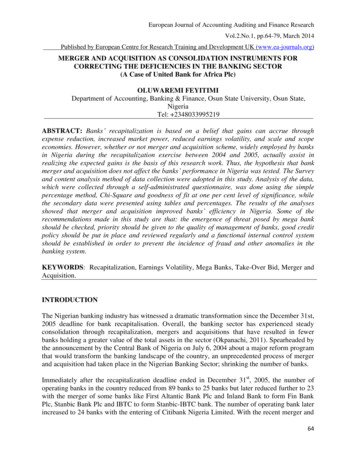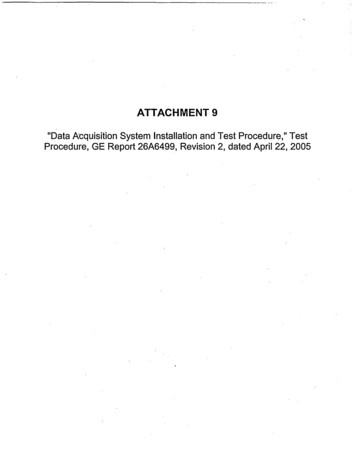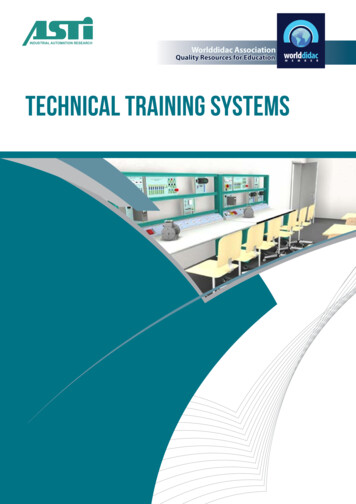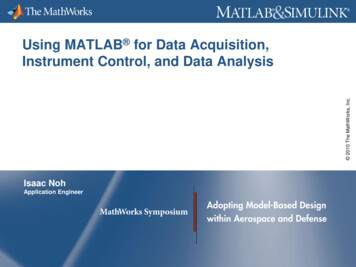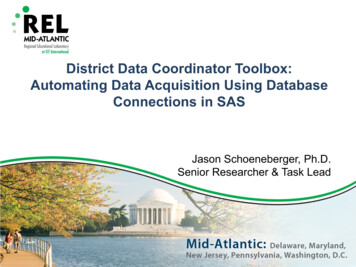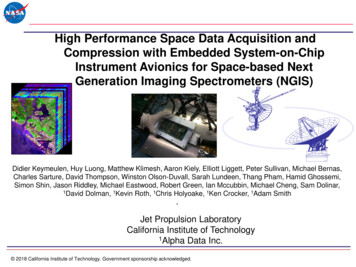
Transcription
High Performance Space Data Acquisition andCompression with Embedded System-on-ChipInstrument Avionics for Space-based NextGeneration Imaging Spectrometers (NGIS)Didier Keymeulen, Huy Luong, Matthew Klimesh, Aaron Kiely, Elliott Liggett, Peter Sullivan, Michael Bernas,Charles Sarture, David Thompson, Winston Olson-Duvall, Sarah Lundeen, Thang Pham, Hamid Ghossemi,Simon Shin, Jason Riddley, Michael Eastwood, Robert Green, Ian Mccubbin, Michael Cheng, Sam Dolinar,1David Dolman, 1Kevin Roth, 1Chris Holyoake, 1Ken Crocker, 1Adam Smith,Jet Propulsion LaboratoryCalifornia Institute of Technology1Alpha Data Inc. 2018 California Institute of Technology. Government sponsorship acknowledged.
Outline Overview of Fast Lossless & near-lossless (FL &FLEX) Data Compression for Multispectral Imager(MSI) and Hyperspectral (HSI) imagers Data Acquisition and FL & FLEX HW/FW/SW for: Airborne Demonstration Space Deployment2
The Need for Compression Imaging spectrometers produce enormous data volumes. A goodcompressor should:– Exploit spectral dependencies and the 3-dimensional structure of MultispectralImager (MSI) and Hyperspectral (HSI) to achieve significantly bettercompression Instead of simply applying 2-dimensional algorithms to each spectral image.– Be fast enough for real-time compression as MSI and HSI data are acquired. Modern imaging spectrometers operate at 10 Msamples/sec (ex:AVIRISng @ 31 Msamples/sec 62 MBytes/sec)– Compress raw, radiance, or reflectance data as needed. Close alignment of AFRL’s and NASA’s needs for MSI/HSI compression:– High speed compression suitable for real-time onboard implementation– Compression specifically tailored to exploit data properties unique to MSI/HSIsensors– Maximize data return over constrained communications channels subject tonoise and other degradations– Maximize utility of delivered data to demanding scientists and other end users3
Fast Lossless (FL) MSI/HSI Compressor: Features Lossless compression – reconstructed image exactly matches original Excellent compression performance General purpose– Demonstrated outstanding performance on several different MSI/HSI imaginginstruments MaRS, HYCAS, ACES HY, plus CCSDS test set including data from 14instruments including multispectral imagers, hyperspectral imagers, andultraspectral sounders Robust – there is no need to know much in advance about the degree of spectral orspatial correlation Low complexity– Algorithm can be implemented in such a way that the operations per sample are: 6 integer multiplications 25 integer add, subtract, or bit shift operations entropy coding operations– Well-suited for hardware implementation– Easily parallelizable– Modest memory requirementCCSDS: Consultative Committee for Space Data Systems4
Fast Lossless (FL) MSI/HSI Compressor: how it worksactualsamplevaluesPredictorMSI/HSI imageApproach: Predictive compression,encoding samples one-at-a-time PredictorBand– Computes predicted samplevalue from previously encodednearby samples (predictionneighborhood illustrated at right)– Adaptively adjusts predictionDirectionof flightweights for each spectral bandvia adaptive linear prediction Entropy Coder– Losslessly encodes thedifference between predictedand actual sample pyCodercompresseddataCross-track 2Cross-trackDirectionof flight 37151948162091011Band 112currentsample3D neighborhood usedfor prediction.5
Fast Lossless Extended (FLEX): near-lossless MSI/HIS datacompressor FLEX achieves higher compression ratios than lossless compression andlossy transform-based methods when operating at high-fidelity compression.– FLEX’s predictor is specifically tailored to exploit the 3D spectral/spatial structureof HSI data. This distinguishes FLEX from general-purpose image compressors(e.g., JPEG2000, JPEG, JPEG-LS) not designed specifically for HSI data. FLEX’s quantizer provides a quantitative guarantee on the nature of the lossintroduced by compression.– By contrast, transform-based compression approaches (e.g., wavelet-basedJPEG2000 or DCT-based JPEG) generally do not control reconstruction errorother than in mean square error (MSE) sense. Relevant image features may belocally distorted by an unquantifiable extent. FLEX’s implementation approach has substantially lower complexity thantransform-based compression approaches Inherits many of the desirablefeatures of the underlying FLcompressor:– Low computational complexity– Single-pass compression &decompression– Automatic adaptation tosource image dataExample of near-lossless compression performance ona calibrated MaRS hyperspectral imageFileSizeBit Rate(bits/sample)CompressionOriginal image file385 MB161 Lossless compression, δ 0135 MB5.62.9 Near-lossless, δ 196 MB4.04 Near-lossless, δ 467 MB2.85.7 δ maximum error in reconstructing the corresponding sample in Data6Number
Airborne Demonstration of FLEX Compression Goal: Airborne In-flight deployment of real-time data calibration and atmosphericcorrection and FLEX lossless and lossy compression of HSI data over wideoperating range.– HSI data are acquired by onboard AVIRIS-NG imaging spectrometer, whichproduces roughly 4 GBytes of raw data per minute during each brief dataacquisition period.– In-flight data calibration and atmospheric correction (Level 1 and Level 2data analysis) is performed during data acquisition. Following a givencollection period, compression can be performed on one of three data types:raw(L0), calibrated radiance(L1) and calibrated reflectance(L2)COTS Hardware– Ruggedized COTS PC Hardware (650 Watts): Supermicro X10DRimotherboard, dual processor Intel Xeon 2.6 GHz (2 each with 14 cores) andeight 32G DDR4, Five Samsung 480GB configured as 1TB RAID 10 with6Gb/s– Ruggedized COTS Alpha data FPGA Hardware (10 Watts): Alpha-Data board ADM-XRC-7V1/VX690T-3 with Xilinx Virtex-7XCV7VX690T-3, Four banks of 2GBytes DDR3 SDRAMs, PCIe x8Gen2 Alpha-Data board ADC-PCIe-XMC designed to carry a single ADM-XMCboard Alpha-Data FMC-CLINK-MINI camera link board: transfers HSI imagedata in real-time (60MBytes/sec) to the Virtex-7– Software/Firmware used for Airborne Deployment Next Generation Data Collection System (NGDCS) (SW and Firmware) Real-time data analysis (SW) for radiance and reflectance RDUCE FLEX software data compression with and without FPGA (SWand/or Firmware)SuperMicro PCHardwareAlpha Data Virtex-7BoardAlpha Data FMC-CLINK-MINIAVIRIS-NG HSI Support Equipment7
Airborne Demonstration of FLEX: Data Processing StepsAnatomy of Flight Line500 GBytes average daily of Science data493 Mbits/s (30.7 MSamples/sec)raw instrument data rate (640cross-track 481 bands 16bits/sample 100 frames/sec)Step1a & 1b:Data Acquisition & Analysis(radiance and reflectance)Step 2: Compression100 sec6 minStep1a & 1b:Data Acquisition & Analysis(radiance and reflectance)Reposition aircraft for next flight lineData Processing FlowStep 1a: Acquire L0 data SSD RAIDCalibratedBlackBody/ShutterStep 1b: L1/L2 realtime data analysis (PC)SynchronizedGPS/IMU data(Level 0)Raw InstrumentData (Level 0)Step 2: ericcorrectionRadiance Data(Level 1)PC/FPGAFLEXCompressionReflectance Data(Level 2)Compressed Data8
Flight Compression Experiments (June15 & 16, 2017) Flight in Southern California in King Air B200 with AVIRISng.Table: Compression options used for each in-flight compression run, with throughput and compression ratiosTypical Data Throughput to compress a 10,000frame image acquire over 100 sec (including R/Wfile): AVIRISng 30.7 MSamples/secData Throughput10,000 Frames ImageFile Read/Write (sec) (SW)PreProcessing (sec) (SW)Compression (sec) (SW/FPGA)Total (sec)Throughput (MSamples/sec)RawSW (28 FPGA (15cores) 1.51CalibratedSW (28 FPGA 67.5062.1245.83Compression Ratio during campaign:Compression syδ 94.7022.5010.39δ maximum error in reconstructing the corresponding sample in Data Number9
System-on-Chip (SoC) Motivation for SpaceCOTS SoC FPGA(e.g. Xilinx Zynq)Zynq launched in May 2012, VendorZynq board in July 2013Zynq SoC 7000: Application Processing Unit:– Double Core CORTEX-A9(Application Profile)– Media Processing Engine(SIMD NEON DSP andFloating Point) Programmable Logic I/O peripherals (54 multiplexedI/O, 64 Extended I/) Built-in Peripherals (USB,Ethernet,SPIs, ) Memory Interfaces PS Interconnects DMA Timers: Public and Private General Interrupt Controller On-Chip RAM (OCM) Debug Controller VIVADO Design SuiteSoC FPGA Space technology(e.g JPL/Alpha Data , NSFCHREC Space Processor)JPL/AlphaData SoC Space Instrument AvionicsWirthlin et al. “ Radiation test withinCenter for High-PerformanceReconfigurable Computing (CHREC)Space Processor (CSP)”, MAPLD, May2015 (pairs Launched on 20 Feb 2017by SpaceX for ISS for Goddard ISEMexperiment ) For space applications requiring two-chip (CPU and FPGA), System-on-Chip (e.g.Zynq) provides as much as 50% less board space, power and system cost for samePerformance and Functionality through:– Chip-level integration which eliminates cost of one of the packages and savesboard space– consolidation external memories between CPU and FPGA to one memory device– Internal Communications between the CPU and FPGA consuming substantiallyless power and offers substantially higher bandwidth and lower latency. Aligned with NASA’s approach to SoC technology to be used for CubeSats/Small Satoperating in Low Earth Orbit (LEO) and deep-space exploration missions10
High Performance Space Data Acquisition and Compression for Next Generation ImagingSpectrometer (NGIS): CapabilitiesDCSEElementBlock DiagramFocal PlaneElectronicsMechanicalMotor he Data Compression and Support Electronics (DCSE) acquires the image from the Focal Plane InterfaceElectronics (FPIE), losslessly (with lossy capability) compresses with cloud screening the data in real-time,packetizes the compressed data and sends the data to the testbed.– DCSE is a hardware board with Zynq Z7045Q which includes Kintex-7 FPGA (equivalent to 5 rad-hardflight Virtex5 FPGA consuming total of 40 Watts) and dual-core ARM Cortex-A9 Processors (equivalent to10 RAD750 (PowerPC) flight processors consuming total of 50Watts)– Acquires 640 480 samples 16 bits (used 14bits), 125 frames/sec from FPA CHROMA producing at inputdata rate of 0.5 Gbits/sec– Lossless compression and cloud screen in real-time hyperspectral data with a compression ratio of up to4:1 producing an output compressed data rate of 126 Mbits/sec– Program frames rates of FPA CHROMA from 1 MSamples/sec to 40 MSamples/sec. (Nominal is 20MSamples/sec with 65 frames/sec)– Provide housekeeping data with instrument health, safety and timing information– Provide digital control of temperature and autofocus mechanism.11
Alpha Data modified COTS, FW and SW for NGIS Alpha Data Alpha Data is a leading supplier of high performance Xilinx FPGA basedcommercial off-the-shelf (COTS) products for embedded system design anddeployment. Focusing on the strategic market areas of digital signal processing (DSP),imaging systems, communications, military and aerospace and highperformance computing (HPC), Alpha Data has established a global customerbase and reputation for leading edge design. Alpha Data offers design services for taking existing COTS products andtailoring them to customers requirements (MCOTS). See www.alpha-data.com for more information. JPL NGIS Spectrometer Project Zynq hardware alone is not enough; highly configurable and complex Xilinxchip needs: Customized FPGA design, and Zynq Processor configuration Customized OS, Yocto Linux distribution (instead of bare metal app) Drivers for custom built interface hardware Alpha Data already has well designed frameworks that allows easymodification and customization, even between different hardwareplatforms Let’s take a look at the modified COTS board and how the highperformance data acquisition and compression system works 12
DCSE modified COTS Alpha Data Boards and InterfaceSpecifications:DCSE Hardware: Flight modification of COTS Alpha DataADM-XRC-7Z1/XQ7Z045-2/CC1A ZyncSoC XMC Defense Grade AlphaData ADC-CUST-&z1 CustomCarrier with buffer, connector, rad hardwatch dog timer and Oscillators. AlphaData Custom Chassis J4PMCJ5XMCDCSE AssemblyJ6XMCCOTS ADM-XRC-7Z1Block DiagramGPIOx146Volume: 190 by 120 by 30 mmWeight: 1KgrPower: 3Watt (ARM); 9 Watt (FPGA ARM)LEO orbit (test COTS parts for destructiveLatch-up; eliminate unused functionalitiesETH, USB, ucontroller) Integrated Rad Hard Parts: oscillator, watchdog timer/hardware reset Memories– Micron QSPI Flash for Booting(2X256Mbits)– Mircron DDR3 SDRAM for PS (512MBytes) and for PL (2X256 MBytes) Interfaces:– 146 LVDS for FPIE raw data,compressed data, Full Camera Link(0.5Gbit/sec)– SPI (Focal Plane Interface Electronics,ROIC, Heaters, Temperature)– RS422 (Cmd & Tlm)GTXAlpha Data Modified COTS ADM-XRC7Z1/XQ7Z045-2/CC1AAlpha Data Custom ChassisAlpha Data Custom ADC-CUST137Z1 for external interface
DCSE Bottom Up: Hardware, FPGA Firmware, Boot ProcedureApplicationApplicationLevel CodeDiagnostic & PerformanceFunctionsDiagnostics and Data AcquisitionFlow ControlAPI (Extends Abstraction adding instrument specific functionality)User ModeAPI CodeC HAL (Hardware Abstraction Layer)ADZ1 DriverEmbedded Linux (Yocto-Poky)Das-uBootFSBLHardware (ADMXRC7Z1 FPGA design)Modified COTS ADM-XRC7Z1/XQ7Z045-2/CC1ACustom ADC-CUST-7Z1OS and LowLevel CodeHardwareCustom CHASSIS Hardware DCSE starts with COTSCPU/FPGA board ADM-XRC-7Z1with ADC-CUST-7Z1 carrier boardfor external interfaces. Build custom high-speed interfaceboard for Focal Plane InterfaceElectronics, GSE Camera Link,LVDS Data compression output,heaters and motor controller,Commands and telemetry, PPS,GSE diagnostic (COM1,JTAG) FPGA Firmware Build customized FPGA/ARMarchitecture with Vivado blockdiagram editor (based of existingexample designs). Add custom VHDL code forapplication specific needs: Interfacing with Camera Link at50MHz, LVDS output at40MHz, LVDS input at 80MHz Data flow control. Hardware data compression Hardware data acquisition. Boot Procedure First Stage Boot Loader (FSBL)begins on power up FSBL loads u-Boot, which in turnloads Yocto Embedded Linux OS14
DCSE Bottom Up: OS, HAL and API ApplicationApplicationLevel CodeDiagnostic & PerformanceFunctionsDiagnostics and Data AcquisitionFlow Control API (Extends Abstraction adding instrument specific functionality)User ModeAPI CodeC HAL (Hardware Abstraction Layer) ADZ1 DriverEmbedded Linux (Yocto-Poky)Das-uBootFSBLHardware (ADMXRC7Z1 FPGA design)OS and LowLevel CodeHardwareOperating System Customized Yocto Embedded Linuxfor NGIS project, not just recompiledkernel, but entire distribution containsonly necessary components Custom Kernel module (ADZ1) for lowlevel CPU/FPGA interaction (used forinterrupts etc)HAL (Hardware Abstraction Layer) Provides non-application specificfunctions for interacting with FPGA,and host operating system Allows underlying hardware and/orOperating System to change withminimal impact to project. Lots of deployment possibilities:other OS, other Alpha Data Cards, orother board vendorsAPI (Application Interface) DCSE API provides application levelinteraction with the NGIS sensor(s). Provides initialization andconfiguration function. DCSE device management:Configuring FPGA Fully programmable: Image Size,Frame Rate, Focal Plane Array,Compression Parameters andClouds Screening Provides functions to start/stop datacapture Provides functions for house keepingdata15
DCSE Bottom Up: Diagnostics, Performance and ApplicationsFM Cmd&TlmRS422 GUI runningon GSE computerApplicationDiagnostic & PerformanceFunctionsDiagnostics and Data AcquisitionFlow ControlAPI (Extends Abstraction adding instrument specific functionality)C HAL (Hardware Abstraction Layer)GSE Diagnostics& Performanceconsole moderunning on ARMADZ1 DriverEmbedded Linux (Yocto-Poky)Das-uBootFSBLEM Focal Plane Interface Electronics &CHROMAHardware (ADMXRC7Z1 FPGA design)GSE Camera Link uncompressed datagrabber running on GSE computer EM LVDS compressed data EM Pulse Per Secondgrabber running on GSEcomputerEM 13 Heaters, 1 Step Motor, 32TemperaturesApplications– Running multiple threads: data flow control, serial Cmd&Tlm, Motor&Heater– Progam camera (CHROMA), focal plane interface electronics (LTC2271), heaters, compression parameters and cloudsscreening parameters.– Control Data Flow: ADC images sample to BIL to BIP transformation to multi core compression to header population topacketisation to LVDS signals– Collect Housekeeping data and synchronization with S/C Time message and PPS– Handle Cmd&Tlm with S/C– Diagnostics to check memory banks, clocks, generate image pattern in FPGA design16
DCSE: Functional and Performance Test Used intensively for all optical and thermalcontrol V&V Test of NGIS Successfully pass thermal cycle andvibration test. Performed functional and performance testat -10 C, 0 C and 15 C in TVAC usingIntegrating Sphere: Programmable frame rate from 1 to 125frames/sec Clouds Screening Detection Lossless GSEtertiarymirror17
SummaryWe presented a high performance data acquisition and datacompression SW/FW/HW targeting Xilinx Virtex 7 FPGAboard for airborne deployment and System-on-Chip (SoC)boards based on modified COTS for space deployment.We have integrated single core FLEX data compressiontargeting Virtex5 FPGA to the ECOSTRESS mission andadapted DCSE data acquisition system for 1280 by 480frames at 240 frame/sec future HSI instrument.Future developments will explore new technologies such asMultiple Processor System-on-the-Chip (MPSoC) and spacequalified XQR Kintex UltraScale FPGA (XQRKU060)embedded with CHROMA-D which will able to providehardware resource needed for real-time radiance,reflectance and data analysis.18
Back-upHyspIRI 2017 talk19
FM DCSE Integrated with NGISData Compressionand SupportElectronicsElement20
Jet Propulsion Laboratory. California Institute of Technology. 1. Alpha Data Inc. High Performance Space Data Acquisition and Compression with Embedded System -on-Chip Instrument Avionics for Space-based Next Generation Imaging Spectrometers (NGIS) Didier Keymeulen, Huy Luong, Matthew Klimesh, Aaron Kiely, Elliott Liggett, Peter Sullivan .




